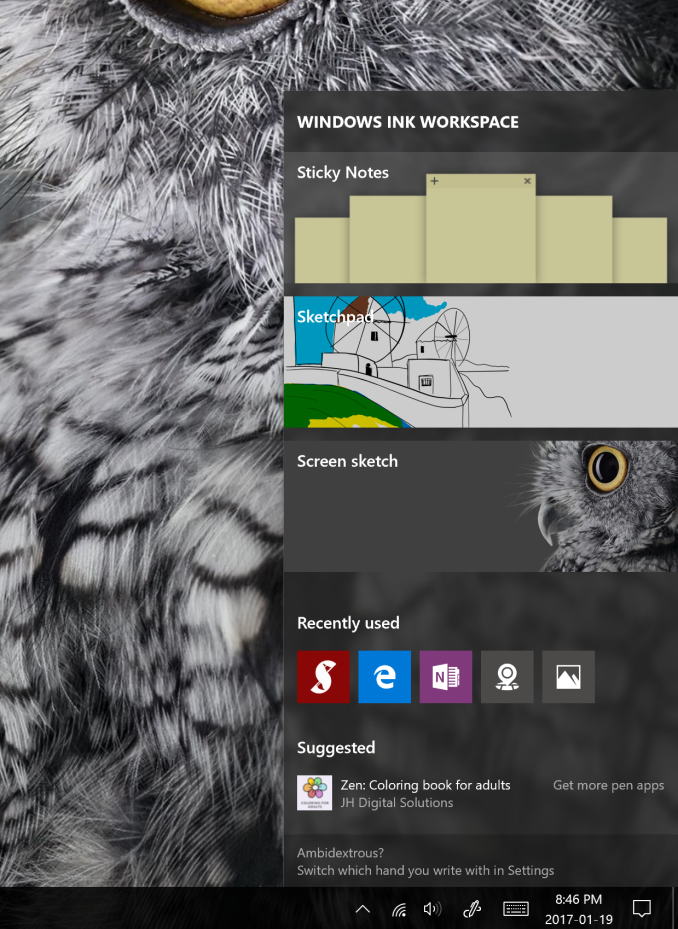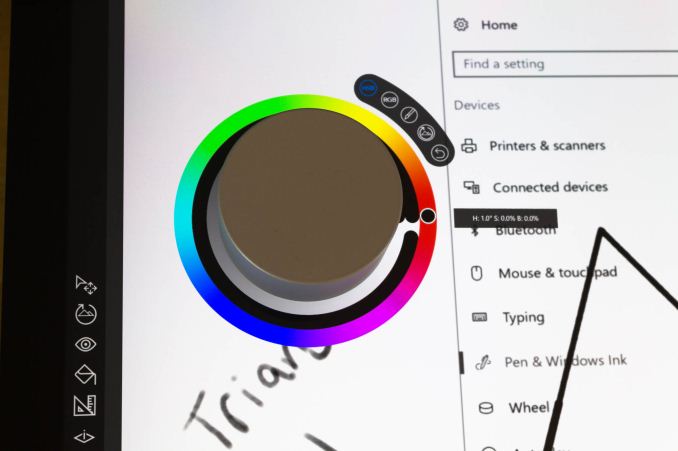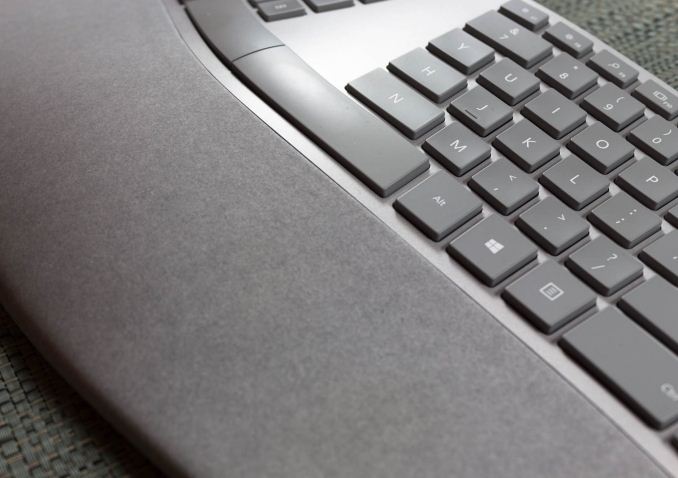The Microsoft Surface Studio Review
by Brett Howse on January 20, 2017 8:00 AM EST- Posted in
- Desktop
- Microsoft
- Surface
- Surface Studio
Final Words
Microsoft’s Surface Studio is arguably the most exciting desktop to launch in a long time. The world has been moving to more portable devices for a while now, with notebook sales overtaking desktops and never looking back. There certainly is an appeal to a large screen desktop though, and for anyone that needs to get a lot done, it’s easy to see why a desktop can make this a more enjoyable experience. The idea of the desktop has been changing for some time though. All-in-one PCs are very popular due to the simplicity of setup, and aesthetics. You no longer need a beige box in the corner powering your office, and small form factor devices like Intel’s NUC have been a strong category in a down market.
Microsoft is targeting creative designers with the Surface Studio, a job that is made much easier thanks to the clever zero-gravity hinge system, and the Studio’s ability to fold down into a drafting table. The massive screen offers a lot of surface area for use with the Surface Pen, and it was no accident the Studio launched at the Windows 10 Creator’s Update event in late October. The Surface Studio is a halo product in this niche, promising a great experience for digital makers. How well it delivers depends on your particular needs, but there is a lot of great aspects to the Surface Studio.
Let’s start with the display, which is the key feature of the entire product. Microsoft has aggressively pursued display improvements with the Surface line, right from the time it was first announced. It has taken a couple of generations of Surface for them to get to where I think they wanted to be, but with the Surface Studio, they’ve really dealt a royal flush. The 28.125-inch display, with 13.5 million pixels, perfectly fits the 200% scaling level meaning items on-screen are the exact right size. Since they are not using any sort of fractional, non-integer scaling, the end result is a display that is incredibly sharp, but with less issues with fonts and the like. High DPI can still be an issue in Windows 10, depending on the applications you run, but it is generally a great experience.
Microsoft decided to cover three different color gamuts on the Surface Studio, with sRGB, DCI-P3, and P3 D65. The only mistake they made was naming P3 D65 “Vivid” mode, which is confusing and non-obvious. Their per-device calibration is spot on, with the Surface Studio being one of the most accurate displays we have ever tested, especially without prior calibration. Out of the box, it is likely one of the most accurate displays on a consumer level device, and it is incredibly accurate in all three color gamuts. Windows 10 itself needs to do a better job with color spaces though. Having an on-screen toggle to choose the color space you want to use is a very usable method of switching, but the Studio owner should not need to do this manually. Despite the high level of accuracy, if someone chooses the wrong color gamut for their content, it is likely to be showing the wrong colors, unless the application itself is color managed, and most are not.
Other than the display, the other stand-out feature of the Surface Studio is the design. With an all-aluminum chassis and display, it looks and feels as premium as it should. The display is only 12.5 mm thick, which Microsoft claims is the thinnest ever designed for this type of device. The proportions of the Studio, with it’s 3:2 display, chrome arms, and PC base, all make it feel like a single cohesive design. The design pays homage to other Surface designs too, with the same type of vent ridge along the top of the base, and it of course is finished in the Surface gray that has become a signature too.
The keyboard and mouse that ship with the Surface Studio also fit well into this design, but the new ergonomic option adds a premium feel with an Alcantara wrist rest. The Surface Pen is the same pen that shipped with the Surface Pro 4 and Surface Book, and it offers a great writing experience, and swappable pen tips. You can customize the sensitivity of the pen as well to suit your own writing style, and the eraser on the top is a nice touch, and it doubles as a clickable button to invoke the Windows Ink Workspace and other programs. Windows 10 has come a long way in terms of pen support, and the forthcoming Creator’s Update will add even more features. The Surface Dial is a very interesting concept, and is well executed. Software support is going to be the key to see if it takes off, but it could be a very popular device with digital artists.
The computer side of the Surface Studio is entirely laptop class parts, with a 45-Watt Intel Skylake CPU, and NVIDIA GTX 965M or GTX 980M GPUs. The choice of a Skylake CPU, rather than wait several months for Intel to release the quad-core Kaby Lake parts, is fine. Kaby Lake is completely a process change, and has no IPC gains over Skylake anyway. The choice to use NVIDIA’s previous generation Maxwell GPUs though was an unsatisfying one, especially considering the resolution of the display. The GTX 980M handles desktop duties just fine, but if you do want to stretch its legs with some games, it really can’t be used much higher than 1920x1080, except on a few select titles like Dota 2. The latest Pascal parts offer more than just gaming performance too, with a lower power consumption, and possibly a cooler, and quieter, Surface Studio. It would have taken some last second effort to redesign the mainboard and cooling to accommodate the Pascal GPUs, but the end result would have been worth it.
The other main issue is the hybrid hard drive as the only storage option. People with desktops may not be ready for smaller SSDs as the boot drive, but it would have been nice to see even a single model of Surface Studio offer a SSD-only (or SSD boot drive) option. My experience with the hybrid drive on the Surface Studio was better than I expected though, and most of the time it was not an issue. There were certain tasks though that clearly ended up hitting the hard drive, and it’s a slow 5400rpm model as well.
The system noise at load is excellent, at just 46 dB, but the system noise at idle is a bit too loud for my tastes. My desktop systems tend to be silent unless heavily loaded, so listening to the fan all the time of the Surface Studio was tiring.
Now let’s talk about pricing and models. The base model starts at $2999, and offers a Core i5-6440HQ and GTX 965M. That is fine, but the 8 GB of RAM is not really enough for a $3000 desktop PC, and since it is soldered on, it can never be upgraded. The base model also features just a 64 GB SATA SSD for the caching drive, and therefore the base model should be avoided if you are looking at the Surface Studio. This is an expensive device, and 8 GB of RAM and a poor storage solution is always going to be a burden. Realistically, the $3499 mid-level model is really the only reasonable place to start shopping for a Surface Studio. For the extra money, the CPU gets bumped to a Core i7-6820HQ, and even more importantly the RAM is doubled to 16 GB, and the caching drive is doubled to 128 GB. The $4199 price tag on the top model is a tough pill to swallow, but the GTX 980M is a big jump up from the GTX 965M, and you also get 32 GB of RAM and a 2 TB hybrid drive. It’s not an inexpensive jump in price though, on an already expensive computer.
The price on the Surface Studio is going to deter many people, but the Surface line seems to be more about offering a product that showcases the best of Windows 10, and Microsoft is leaving enough room for other manufacturers to come into the category as well. That has worked very well for them with the Surface Pro 4, and already at CES, Dell was showcasing their own Dell Canvas display, offering much of the same ideas as the Surface Studio, but without the insanely high resolution, build quality, and most importantly, price. In spite of the high price, Surface Studio stock is in short supply, with the device sold out at both the Microsoft Store and retail partner Best Buy, with ship esitimates up to six months out for the top end model. The Surface Studio is not perfect, and it’s very expensive, but it’s hard not to want one.














197 Comments
View All Comments
vLsL2VnDmWjoTByaVLxb - Friday, January 20, 2017 - link
The second one 3 months in? After Microsoft kept promising driver/firmware updates to address the issues?It's a business laptop that was going to be a test case for our company, selling it isn't our job. Microsoft extended the warranty, and we decided on XPS 15's instead for our fleet. (which work nearly flawlessly in comparison.)
It wasn't capable of reliable external display/peripheral use either, the dock sucked.
Icehawk - Sunday, January 22, 2017 - link
Yeah we have SP3s, 4s, and SBs at my work and none of them work reliably with more than one monitor. Our clients just love that.sprockkets - Saturday, January 21, 2017 - link
Not trying to troll, but that's like every MS computer since forever.I have an Asus computer that can't wake up either with Windows 8 or 10. Works fine with Linux, SuSE 42.1. Yea, linux isn't perfect but MS has had decades to get standby right, and can't.
Remember the last time an ios or android device failed to wake up when hitting the power button? Me either.
philehidiot - Sunday, January 22, 2017 - link
Sprokkets, that's a damned good point. How can waking from a sleep state continue to confuse Microsoft when as you rightly point out, phones do it multiple times a day flawlessly. It's maddening and you can't realistically sleep your PC during critical work without saving everything (and when you've multiple tabs, papers, word, Excel and PowerPoint documents open that's one big pain in the arse).thebuccaneergentleman - Sunday, January 22, 2017 - link
I don't know if EVERY MS computer is like this... Some are and some are not. We deployed hundreds of Surface Pro 1, 2 and 3s over the years at my company. Some were very good... many were not. The higher-ups though decided to pass on the Surface Pro 4 and started to purchase Lenovo laptops. It was a good call. Our IT support cases have dropped into single digits for the new Lenovos. MS had a PERFECT idea with the Surface. I LOVE the concept. But their execution (at least till the Surface Pro 3 as I have not used a SP4) was less than stellar. Too bad. Its hard to rebound from even a small bad batch.niva - Wednesday, January 25, 2017 - link
Yeah that's a ridiculous statement.I've been using linux for about 10 years now on all sorts of computers. Typically you will encounter issues in linux exactly with things like standby and sleep mode, even if everything else works out of the box. Don't even get me started on drivers for new hardware like dedicated graphics or application support. I've stayed with Windows pretty much 100% due to my Photoshop needs. Sure I game some on my desktop too, but these days even that wouldn't be enough.
I love linux, it's great for many things, especially for the price, but the area you brought up as an advantage somehow you're completely wrong about.
This new device from Microsoft is interesting. The price is ridiculous though. I'll wait for future generations and see how things go in the future. As an artist I'm definitely interested in these types of devices.
tamalero - Sunday, January 22, 2017 - link
There are a lot of stuff that Microsoft hs fucked up over the years.For example.. if your monitors turn off (multiple monitors). Your color calibration information resets to default.
Shutting down any monitor will now cause all the icons to switch to the remaining monitor and the color calibration will be lost as well.
Microsoft support tech(from India and Turkey) only kept repeating the same BS recipe of "reboot, didnt work? then boot in safe mode" and then end with "Its working as intended, its not a bug. We will report this to the developers for xxx reason" and nothing..
Rezurecta - Friday, January 20, 2017 - link
MS support is good. Just get you surface exchanged.geekman1024 - Saturday, January 21, 2017 - link
MS support is good, but their hardware products' quality isn't.My Surface 3's pen function is bad straight out of the box, so I have to send it in for repair the day I've got it. The Surface Pen 4 I've bought for the Surface have its bluetooth function working intermittently, most of the time the top button click doesn't work. Then I remembered I used to have a MS wireless laser mouse + keyboard combo which died 3 months after purchase. My XBox 360 RRoD'ed just a few weeks after warranty expired, nice calculation on the MTTF, Microsoft.
Seems like EVERY MS hardware product I owned have to turn bad at some time. Is it my bad luck or MS's QC needs some debugging?
goatfajitas - Monday, January 23, 2017 - link
Exactly... I dont want good support nearly as much as I want it to not break... Same reason I dont buy a Kia with a 10 year 100,000 mile warranty. I dont want it to break and be fixed for free, I want to not be stuck with a broken car I have to deal with regardless of who pays for it. This comment section alone is riddled with Surface Pro and Surface Book users reporting all sorts of issues. Pass. Big time pass.